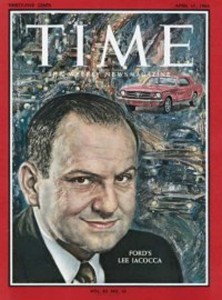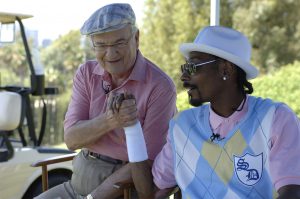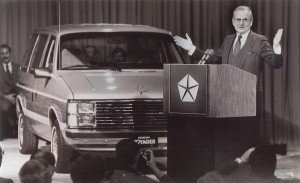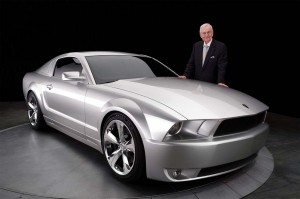Lee Iacocca, who was born to struggling immigrant parents in Allentown, Pennsylvania and who grew up to become one of the most influential executives in automotive history, has died at the age of 94.
Trained as a an engineer, Lido Anthony Iacocca’s real skills proved to be his uncanny ability to sense what people wanted and then tell them why they should buy it. During his tenure as Chrysler Corp. chairman, he appeared in over 100 TV commercials, repeating his catchphrase, “If you can find a better car, buy it.” He came back to what was then DaimlerChrysler more than a decade after retiring to do a few more spots, among them one in which the then-octogenarian partnered with rapper Snoop Dog.
During his lengthy career, Iacocca played a critical role in the development of three iconic vehicles, including the Ford Mustang, the Chrysler K-Cars and that automaker’s long-popular minivans. But it was his charitable work, including the rescue of the Statue of Liberty and the Ellis Island immigration center, where his parents first stepped foot in America, that Iacocca said he was most proud of, late in life.
“Lee had a touch of the common man,” said Bud Liebler, who served in a variety of senior positions during Iacocca’s years at Chrysler. “He could reach out and talk to people like no one else.”
Iacocca demonstrated that skill early in a career that began shortly after graduating from Princeton in 1946. He signed on with Ford which was then being transformed by the “Wiz Kids,” a group of Army veterans who helped revive the automaker after it nearly went bust during World War II. He quickly landed on the Ford fast track and, by the time he was 36, he was already a vice president, at 43 an executive VP and then, in December 1970, the 46-year-old was named Ford president.

Barely 40, Iacocca landed on the cover of Time as the man credited with bringing the Ford Mustang to life.
Iacocca had already scored some notable successes, starting with the “56 for 56 campaign,” that lined up customers for Ford’s 1956 models priced at just $56 a month. But his real score was the 1964-1/2 Mustang which clicked with a new generation of American buyers who didn’t want to buy the same, stolid sheet metal that their parents were driving. Iacocca had to fight for the $75 million he needed for the project, but the little “pony car” paid off almost overnight. Ford expected to sell, at most 100,000 the first year. It delivered 418,000. It remains the world’s best-selling sports car today.
But Iacocca’s tendency to “shake the bushes,” as Liebler put it, also rattled a lot of cages. He repeatedly found himself facing down Ford chairman and family heir Henry Ford II who, on July 13, 1978, fired Iacocca, reportedly telling him, “I just don’t like you.”
It didn’t take Iacocca long to line up another job, albeit one with a seemingly very shaky future as president and CEO of the floundering Chrysler Corp.
“He was the perfect guy to come along at precisely the right time for Chrysler,” said David Cole, the chairman-emeritus of the Center for Automotive Research and son of a former General Motors president who was an Iacocca contemporary.
Racing against time, Iacocca and “the Gang of Ford,” a group of fellow alums who followed him to Chrysler, crafted a complex bailout plan that called for concessions by union workers banks, suppliers, and both U.S. and Canadian governments.
After unveiling the plan during a news conference at Chrysler headquarters in the Detroit enclave of Highland Park, Iacocca was asked by a clearly skeptical reporter what would happen if it didn’t come together exactly as outlined, “Then the pieces of the mosaic will fall off the wall,” he responded.
“Lee had a touch of the common man,” said Liebler. “He could reach out and talk to people like no one else.” As a result, added Liebler, who now owns the tony Whitney restaurant in downtown Detroit, he often felt that Chrysler wasn’t selling K-Cars or minivans, but “Iacocca-mobiles.”
By the middle of the 1980s, the smallest of the Detroit automakers was soaring. And that led a confident Iacocca to put things on autopilot as he shifted focus to some of his personal passions. He put out his autobiography, the first in a long series of books. He began making acquisitions, including Italian supercar company Lamborghini and aerospace company Gulfstream. And he turned to several charitable projects, notably the effort to restore the crumbling Statue of Liberty, as well as the long-abandoned Ellis Island.

In 2005, Iacocca launched a new series of ads for Chrysler, including one pairing him with rapper Snoop Dog.
In his later years, Iacocca explained, “All the success I’ve had,, all the jobs I’ve saved and the lives I’ve influenced would never have happened if my parents had been turned away at Ellis Island.”
But all the distractions took a toll on Chrysler and, by the end of the decade it was again heading into deep financial trouble. Yet, even as Iacocca passed 65, he showed no interest in handing over the reins, leading frustrated Chrysler insiders to suggest that his name was really an acronym, short for “I Am Chairman of Chrysler Corporation, Always.”
Finally, the board of directors had enough, convincing the chairman to retire at the end of 1992. But Iacocca couldn’t quite let go, something that created a nightmare for his hand-picked successor, Bob Eaton, when the former chairman teamed up with Las Vegas billionaire Kirk Kerkorian on a short-lived hostile takeover attempt. Chrysler beat it back but, Eaton later acknowledged, it convinced him to look for a deep-pocket partner. In 1998, it teamed up as the U.S. half of DaimlerChrysler with the German parent of Mercedes-Benz.
Chrysler struck back, initially suspending Iacocca’s hefty pension. It later reopened the purse and, by 2005, all seemed to be forgiven. The German-American company even invited the former chairman back for one more swing as corporate spokesman. Arguably the most memorable TV spot paired Iacocca with rapper Snoop Dog. As he repeated his trademark line, “If you can find a better car, buy it,” the rapper offered his own interpretation: “If the ride is more fly, then you must buy.”
“He’s just a good kid, Iacocca later told USA Today, though he admitted he had trouble with Snoop Dog lines like “Fo shizzle, I-ka-zizzle.” “I didn’t understand half the things he was telling me,” said Iacocca, “but it was fun.”
Even after his late-in-life TV pitchman gig wound down, Iacocca continued looking for new opportunities. He also stepped up his charitable work for, among other things, diabetes research. That honored first wife Mary who died of the disease. Iacocca later would marry, and subsequently divorce, twice.
The industry legend began slowing down in his last couple years, according to Liebler, who remained in contact. Iacocca suffered from a number of illnesses and finally succumbed to complications from Parkinson’s Disease, according to his daughter, Lia Iacocca Assad.
As word of Iacocca’s death at his Bel Air, California home started to circulate, tributes began pouring in.
“Lee gave us a mindset that still drives us today – one that is characterized by hard work, dedication and grit,” said a statement from what is today Fiat Chrysler Automobiles. “His legacy is the resiliency and unshakeable faith in the future that live on in the men and women of FCA who strive every day to live up to the high standards he set.”
Iacocca is survived by two daughters, Lian and Kathryn, and eight grandchildren.There has been no official word yet on funeral or other arrangements.
(When it comes to execs-as-icons, Elon Musk may be the only one left. Click Here for the story.)



Closed door meetings between Lee and Hank the Deuce must have been priceless.
Paul, a very nice piece, well done. Chrysler bailout was one of my first stories in Detroit. I hit town 13 days before Henry Ford II fired him…
Thanks, Bob, and great to hear from you! Anyone who covered the beat in that era has memories of Iacocca.
Paul E.